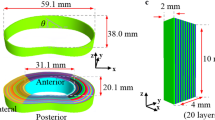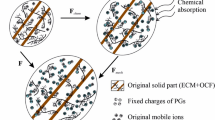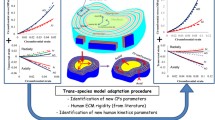Abstract
Mechanical function of the annulus fibrosus of the intervertebral disc is dictated by the composition and microstructure of its highly ordered extracellular matrix. Recent work on engineered angle-ply laminates formed from mesenchymal stem cell (MSC)-seeded nanofibrous scaffolds indicates that the organization of collagen fibers into planes of alternating alignment may play an important role in annulus fibrosus tissue function. Specifically, these engineered tissues can resist tensile deformation through shearing of the interlamellar matrix as layers of collagen differentially reorient under load. In the present work, a hyperelastic constitutive model was developed to describe the role of interlamellar shearing in reinforcing the tensile response of biologic laminates, and was applied to experimental results from engineered annulus constructs formed from MSC-seeded nanofibrous scaffolds. By applying the constitutive model to uniaxial tensile stress–strain data for bilayers with three different fiber orientations, material parameters were generated that characterize the contributions of extrafibrillar matrix, fibers, and interlamellar shearing interactions. By 10 weeks of in vitro culture, interlamellar shearing accounted for nearly 50% of the total stress associated with uniaxial extension in the anatomic range of ply angle. The model successfully captured changes in function with extracellular matrix deposition through variations in the magnitude of model parameters with culture duration. This work illustrates the value of engineered tissues as tools to further our understanding of structure–function relations in native tissues and as a test-bed for the development of constitutive models to describe them.
Similar content being viewed by others
References
Ateshian GA (2007) Anisotropy of fibrous tissues in relation to the distribution of tensed and buckled fibers. J Biomech Eng 129: 240–249
Baker BM, Mauck RL (2007) The effect of nanofiber alignment on the maturation of engineered meniscus constructs. Biomaterials 28: 1967–1977
Baker BM, Nathan AS, Huffman GR, Mauck RL (2009) Tissue engineering with meniscus cells derived from surgical debris. Osteoarthr Cartil 17: 336–345
Bland JM, Altman DG (1986) Statistical methods for assessing agreement between two methods of clinical measurement. Lancet 307(310): 307–310
Cassidy JJ, Hiltner A, Baer E (1989) Hierarchical structure of the intervertebral disc. Connect Tissue Res 23: 75–88
Driscoll TD, Nerurkar NL, Jacobs NT et al (in press) Shear mechanics of electrospun scaffold for annulus fibrosus tissue engineering. J Mech Behav Biomed Mater
Eberline R, Holzapfel GA, Schulze-Bauer CA (2001) An anisotropic constitutive model for annulus tissue and enhanced finite element analyses of intact lumbar disc bodies. Comput Methods Biomech Biomed Eng 4: 209–230
Elliott DM, Setton LA (2001) Anisotropic and inhomogeneous tensile behavior of the human anulus fibrosus: experimental measurement and material model predictions. J Biomech Eng 123: 256–263
Fung YC (1982) Biomechanics: mechanical properties of livign tissues, 2nd ed. p 568
Guerin HA, Elliott DM (2005) The role of fiber-matrix interactions in a nonlinear fiber-reinforced strain energy model of tendon. J Biomech Eng 127: 345–350
Guerin HA, Elliott DM (2006) Degeneration affects the fiber reorientation of human annulus fibrosus under tensile load. J Biomech 39: 1410–1418
Guerin HL, Elliott DM (2007) Quantifying the contributions of structure to annulus fibrosus mechanical function using a nonlinear, anisotropic, hyperelastic model. J Orthop Res 25: 508–516
Guo ZY, Peng XQ, Moran B (2006) A composites-based hyperelastic constitutive model for soft tissue with application to the human annulus fibrosus. J Mech Phys Solids 54: 1952–1971
Holzapfel GA (2000) Nonlinear solid mechanics: a continuum approach for engineering. Wiley, West Sussex, p 455
Holzapfel GA, Schulze-Bauer CA, Feigl G, Regitnig P (2005) Single lamellar mechanics of the human lumbar anulus fibrosus. Biomech Model Mechanobiol 3: 125–140
Klisch SM, Lotz JC (1999) Application of a fiber-reinforced continuum theory to multiple deformations of the annulus fibrosus. J Biomech 32: 1027–1036
Marchand F, Ahmed AM (1990) Investigation of the laminate structure of lumbar disc annulus fibrosus. Spine 15: 402–410
Mauck RL, Yuan X, Tuan RS (2006) Chondrogenic differentiation and functional maturation of bovine mesenchymal stem cells in long-term agarose culture. OA&C 14: 179–189
Mauck RL, Byers BA, Yuan X, Tuan RS (2007) Regulation of cartilaginous ECM gene transcription by chondrocytes and MSCs in 3D culture in response to dynamic loading. Biomech Model Mechanobiol 6: 113–125
Mauck RL, Baker BM, Nerurkar NL et al (2009) Engineering on the straight and narrow: the mechanics of nanofibrous assemblies for fiber-reinforced tissue regeneration. Tissue Eng Part B Rev 15: 171–193
Nerurkar NL, Elliott DM, Mauck RL (2007) Mechanics of oriented electrospun nanofibrous scaffolds for annulus fibrosus tissue engineering. J Orthop Res 25: 1018–1028
Nerurkar NL, Mauck RL, Elliott DM (2008) ISSLS prize winner: integrating theoretical and experimental methods for functional tissue engineering of the annulus fibrosus. Spine (Phila Pa 1976) 33: 2691–2701
Nerurkar NL, Baker BM, Sen S et al (2009) Nanofibrous biologic laminates replicate the form and function of the annulus fibrosus. Nat Mater 8: 986–992
Nerurkar NL, Sen S, Huang AH et al (2010) Engineered disc-like angle-ply structures for intervertebral disc replacement. Spine (Phila Pa 1976) 35: 867–873
Nerurkar NL, Han W, Mauck RL, Elliott DM (2011) Homologous structure-function relationships between native fibrocartilage and tissue engineered from MSC-seeded nanofibrous scaffolds. Biomaterials 32: 461–468
O’Connell GD, Sen S, Baker BM et al (2007) Biaxial mechanics of native and engineered fiber-reinforced musculoskeletal tissues. In: Proceedings of ASME 2007 summer bioengineering conference, Keystone, CO
O’Connell GD, Guerin HL, Elliott DM (2009) Theoretical and uniaxial experimental evaluation of human annulus fibrosus degeneration. J Biomech Eng 131: 111007
Ogden RW (1997) Non-linear elastic deformations
Peltz CD, Perry SM, Getz CL, Soslowsky LJ (2009) Mechanical properties of the long-head of the biceps tendon are altered in the presence of rotator cuff tears in a rat model. J Orthop Res 27: 416–420
Smith LJ, Fazzalari NL (2009) The elastic fibre network of the human lumbar anulus fibrosus: architecture, mechanical function and potential role in the progression of intervertebral disc degeneration. Eur Spine J 18: 439–448
Spencer AJM (1972) Deformations of fibre-reinforced materials. Oxford University Press, p 128
Sun DD, Leong KW (2004) A nonlinear hyperelastic mixture theory model for anisotropy, transport, and swelling of annulus fibrosus. Ann Biomed Eng 32: 92–102
Wagner DR, Lotz JC (2004) Theoretical model and experimental results for the nonlinear elastic behavior of human annulus fibrosus. J Orthop Res 22: 901–909
Wagner DR, Reiser KM, Lotz JC (2006) Glycation increases human annulus fibrosus stiffness in both experimental measurements and theoretical predictions. J Biomech 39: 1021–1029
Author information
Authors and Affiliations
Corresponding author
Rights and permissions
About this article
Cite this article
Nerurkar, N.L., Mauck, R.L. & Elliott, D.M. Modeling interlamellar interactions in angle-ply biologic laminates for annulus fibrosus tissue engineering. Biomech Model Mechanobiol 10, 973–984 (2011). https://doi.org/10.1007/s10237-011-0288-0
Received:
Accepted:
Published:
Issue Date:
DOI: https://doi.org/10.1007/s10237-011-0288-0




